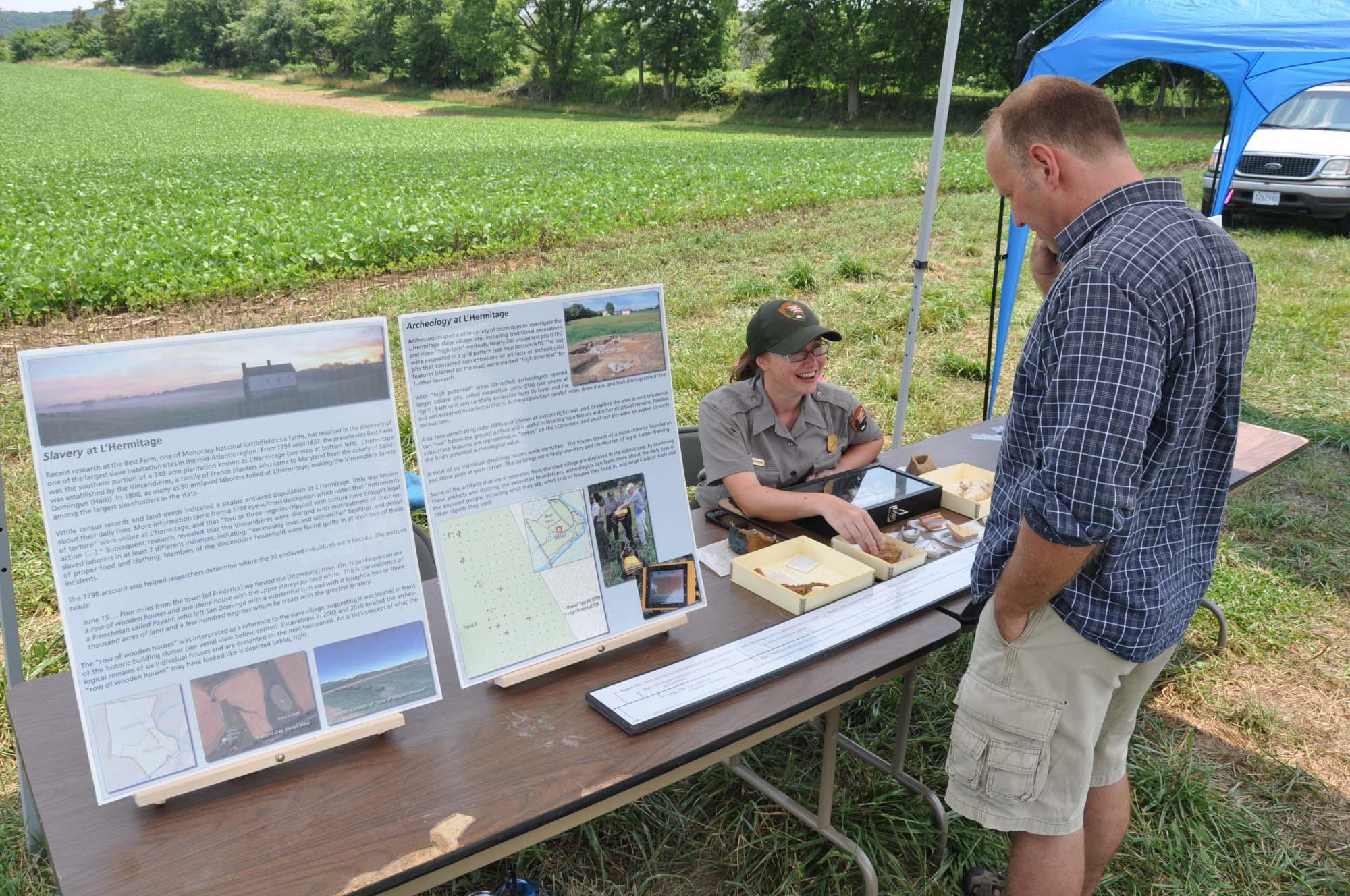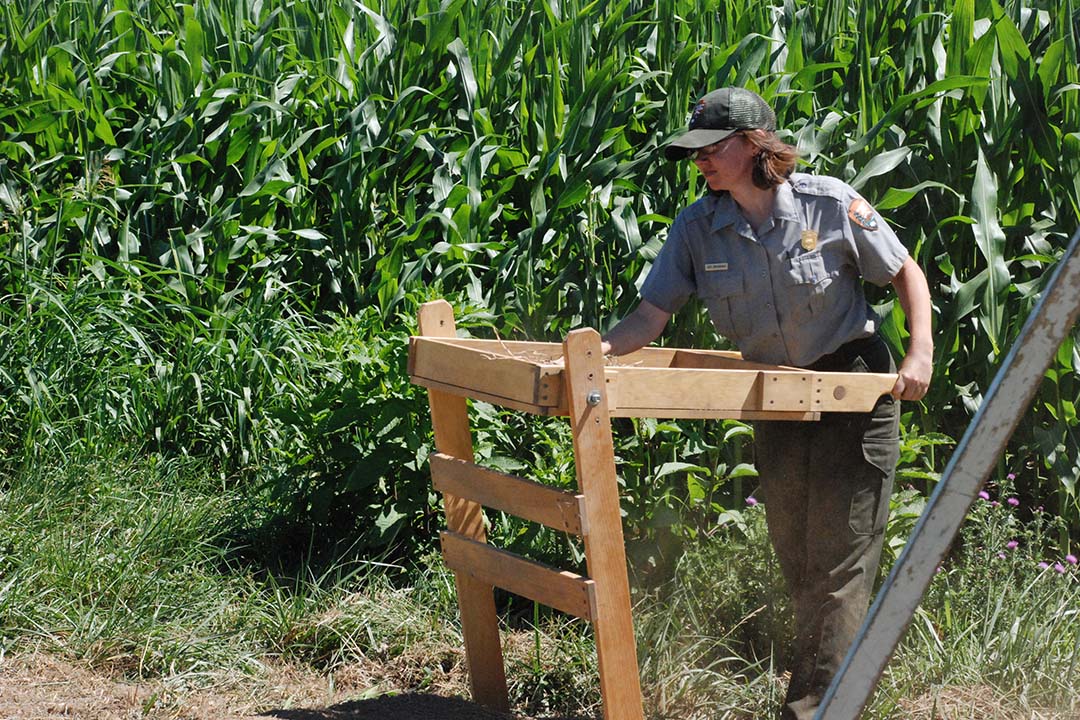By John DiConsiglio
No one has ever confused the Anacostia River with the mighty sweep of the Nile. But to archaeologist Kate Birmingham, MA ’10, a cultural resources program manager with the National Park Service (NPS), the Washington waterway is as rich in history as any of the world’s most celebrated rivers. From the traces of Native American settlements along the Anacostia banks to the prehistoric history of Piscataway Park, Birmingham calls the D.C. region an archaeological research gold mine for anyone willing to explore it.
“When people hear ‘archaeology,’ they picture mummies,” she said. “No one thinks of cities as historic sites. But discoveries are made all the time, right here in our own community.”
Since graduating the Museum Studies Program with a focus in collections management, Birmingham, who holds an undergraduate degree in archaeology from the University of Pittsburgh, has championed urban archaeology. At NPS, she engages the public in local excavation finds. She oversees archaeological activity and collections care for 16 sites, such as Fort Washington Park and the Frederick Douglass House. She was a leader in an award-winning excavation of a hidden Maryland slave village. And now she’s training the next generation of explorers through a NPS youth initiative.
“Everything you find at every site—every button, every oyster shell, every block of stone and mortar—helps paint the landscape of our collective past,” she said. “I want my passion for my work to inspire the young historic preservationists of the future.”

Birmingham educates D.C. residents on the region’s archaeological history. “Discoveries are made all the time, right here in our own community,” she said.
Preserving the Past
Birmingham was bitten by the archaeology bug as a child. Her inspiration came not from an Indiana Jones adventure, but from a staid PBS documentary on the excavation of olive oil jars in Greece. “It wasn’t very romantic, not like finding gold in ancient Egypt,” she recalled. “But when I saw that crew pulling row upon row of jars from the dirt, I thought, ‘That’s it, that’s what I want to do.’”
After working as an archaeologist for private firms, her focus shifted to the care of valuable collections. Archaeology, she surmised, doesn’t end with the dig. All too often, Birmingham saw precious artifacts ignored or mishandled. “Once you do an excavation, you have essentially destroyed your work site. You can’t repeat your experiment,” she noted. From rusty nails to chipped ceramic bowls, artifacts must be recorded, labeled and bagged with precision. “You can’t randomly throw things in a box and put them on a shelf,” she said.
Birmingham enrolled in the Columbian College Museum Studies Program to gain practical experience in collections care and learn from working professionals. “Kate was highly organized and a good communicator—two critical skills for success in her chosen field of collections care,” said Assistant Director of Museum Studies Martha Morris, Birmingham’s academic advisor. As part of the program's internship component, Birmingham cataloged archaeological collections at the NPS, leading directly to her current job. “Many of our graduates focus on collections care and are now working in a variety of interesting positions around the country,” Morris said.
At the NPS, Birmingham made headlines when her team uncovered the remains of an historic slave village, among the largest in Maryland. Using ground-penetrating radar, her crew identified the foundations of six slave quarters on L'Hermitage, a 740-acre Frederick County plantation owned by a notoriously cruel French family. By 1800, L'Hermitage was home to 90 slave laborers, 10 times the number the plantation could sustain. As field director, Birmingham supervised the excavation, often coordinating volunteers and interns as they sifted through buttons, buckles and animal bones—all clues to the slaves’ day-to-day ordeals.
With the site open to the public, Birmingham guided crowds of onlookers through the excavation process. “They looked over our shoulders and asked questions literally as we pulled artifacts out of the dirt,” she said. “They saw discoveries happen as we made them.” Her efforts were recognized with the prestigious 2014 John L. Cotter Award for Excellence in National Park Service Archeology.
Birmingham also brings her passion for discovery to the Urban Archeology Corps, an eight-week summer internship that introduces young people from greater D.C. to archaeology in urban settings. “Many of them have never seen archaeology in action and probably never considered it as a career,” she noted. Among other projects, the students engage in a trash pick-up activity, sorting through park garbage like explorers sifting through ruins. Birmingham then advises them on how to use those skills in an actual archaeological setting. “As archaeologists, we are looking at people’s trash from the past,” she said. “You can apply those same principles to trash left behind today. It’s a record of where people were, and what they were doing.” Birmingham proudly notes that some of her former students are current NPS employees.
Today, Birmingham spends less time excavating sites than advising park managers on how to preserve them. “The work is important and rewarding, and I don't track as much dirt into my car,” she laughed. Still, she fondly recalls the calm sunny mornings she picked up a shovel and trawl and dug alongside her interns at the plantation site. “I can still smell the grass and hear the tools striking the dirt,” she said. “Those are the moments you feel like you are doing something that impacts and enhances our knowledge of history. Those are really heavy moments.”


